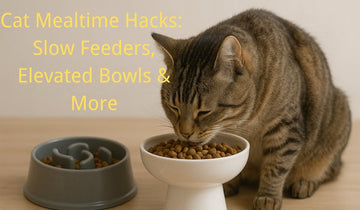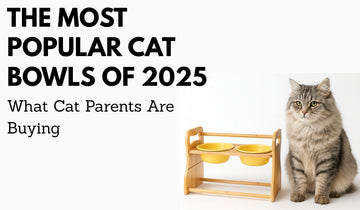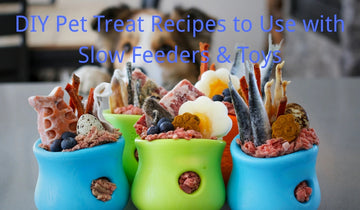Cats may be graceful, but many still bolt their food, overeat, or struggle with whisker stress at the bowl. The right setup—a well-designed cat slow feeder, the best cat bowl material for hygiene, and the correct elevated cat bowl height—can transform digestion, mood, and mealtime manners. Below is a professional, vet-informed guide to optimizing your cat’s feeding station, plus practical feeding tips for cats you can implement today.
Quick win: A slow feeder + slightly elevated ceramic bowl + portion control will solve 80% of fast-eating and post-meal discomfort issues.

Why Cats Benefit from Slow Feeders
A cat slow feeder (maze bowl, lick mat, puzzle dish) introduces gentle obstacles that reduce gulping, which can help with:
-
Better digestion: Slower intake encourages chewing and saliva mixing.
-
Less regurgitation & gas: Minimizes swallowed air during frantic eating.
-
Calmer behavior: Foraging and problem-solving add mental enrichment.
-
Weight management: Extends mealtime duration, helping satiety cues kick in.
Pro tip: Match the obstacle height to kibble size. If the maze is too deep, some cats give up; too shallow and it won’t slow them down.
Elevated Cat Bowl Benefits (When & Why to Raise the Bowl)
Elevating a bowl by a few centimeters can support:
-
Neck & joint comfort: Helpful for seniors, cats with arthritis, or large breeds.
-
Smoother swallowing: A neutral neck angle may reduce air intake and post-meal burps.
-
Tidier station: Elevated stands limit bowl movement, reducing spills.
How high is “right”? For most adult cats, the rim should sit roughly 3–8 cm (1–3 in) above the floor—low enough to keep a relaxed posture, high enough to avoid crouching strain. Observe your cat’s spine: aim for a flat, neutral line while eating.
Choosing the Best Cat Bowl: Material, Shape & Size
1) Material Matters
| Material | Pros | Cons | Best For |
|---|---|---|---|
| Ceramic (glazed, lead-free) | Non-porous, easy to sanitize, heavier (stable), stylish | Can chip if dropped (inspect regularly) | Daily meals, water, whisker-friendly wide bowls |
| Stainless Steel (304/316) | Durable, dishwasher-safe, hygienic | Light/noisy, basic looks | Travel, outdoor, multi-cat homes |
| Plastic | Inexpensive, light | Scratches harbor bacteria; possible odors/irritation | Short-term or backup use only |
Takeaway: For most homes, ceramic or stainless are the best cat bowl choices for hygiene and longevity. If you love aesthetics and weighty stability, go ceramic; if you need unbreakable and ultra-low maintenance, go stainless.
2) Shape & Size
-
Whisker-friendly width: Choose bowls wider and shallower to prevent whisker fatigue.
-
Capacity: Don’t oversize—large bowls invite over-portioning.
-
Anti-slip base: A heavier bowl (or silicone ring) keeps the station quiet and secure.
Explore premium, whisker-friendly ceramic options at Noka&Aurorastone.
Slow Feeder Formats That Work for Cats
-
Maze Bowls: Ridges and channels slow kibble without frustration.
-
Lick Mats: Great for wet food; licking soothes and extends mealtime.
-
Puzzle Plates: Sliding tabs and wells add just enough challenge.
-
Hybrid Stands: Elevated platforms that accept slow-feeder inserts combine posture and pace control.
Set difficulty correctly: Start easy (shallow maze, soft pate on lick mat). Gradually increase complexity to maintain engagement without stress.
Feeding Tips for Cats: Daily Playbook
-
Split Meals: 3–4 smaller servings > 1–2 large dumps. Supports steady energy and digestion.
-
Mix Textures: Combine crunchy kibble with a small portion of wet food on a lick mat to slow intake.
-
Pre-Meal Play: 5–10 minutes of wand-toy play taps into “hunt–eat–groom–sleep” cycles, cutting post-meal zoomies.
-
Water Strategy: Wide, separate ceramic bowl (or fountain). Many cats drink more when water is away from food.
-
Hygiene Routine: Wash bowls daily; sanitize slow feeders thoroughly (ceramic/stainless are easiest). Replace any item that’s chipped or deeply scratched.
Multi-Cat Households: Keep the Peace
-
Individual Stations: Feed each cat at a separate spot (or height) to reduce resource guarding.
-
Timed Sessions: 15–20 minutes, then pick up leftovers.
-
Personalized Hardware: Different slow-feeder designs per cat prevent “food theft” and let you tune difficulty.
Troubleshooting Common Mealtime Issues
-
Still Gulping? Try a deeper maze, smaller kibble size, or partial wet food on a lick mat.
-
Giving Up on the Feeder? Lower difficulty, use higher-value toppers (a teaspoon of tuna water), and praise calmly.
-
Messy Eater? Heavier ceramic, a silicone mat under the stand, and a slightly raised height help a lot.
-
Frequent Vomiting or Weight Loss? Slow feeding helps functional issues, but persistent symptoms warrant a vet check.
Quick Start Kit (Editor’s Picks)
-
Cat slow feeder + lick mat (for wet and dry flexibility)
-
Elevated ceramic stand (3–8 cm rim height)
-
Wide, shallow water bowl (separate location)
-
Silicone under-mat (stability + clean-up)
Build your kit at Noka&Aurorastone—curated ceramic slow feeders, elevated stands, and whisker-friendly designs for healthier, calmer mealtimes.
FAQ
Q1: Are slow feeders good for cats?
Yes. They help prevent gulping, reduce regurgitation, and provide mental enrichment without stressing the joints.
Q2: What’s the ideal height for an elevated cat bowl?
For most adults, a rim height of 3–8 cm (1–3 in) supports a neutral neck and easy swallowing.
Q3: What is the best cat bowl material?
Ceramic (glazed, lead-free) and stainless steel are most hygienic and durable. Avoid scratched plastic.
Q4: How do I stop my cat from eating too fast?
Use a cat slow feeder, split meals, add a lick mat for wet food, and schedule short play before feeding.
Ready to Upgrade Your Cat’s Mealtime?
Transform digestion, comfort, and behavior with the right hardware.
👉 Shop cat slow feeders, elevated bowls, and ceramic essentials at Noka&Aurorastone.







